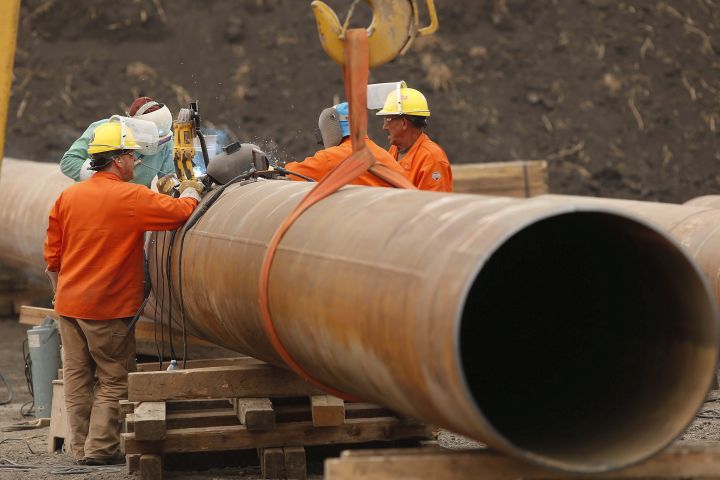Editor’s note: ImpactAlpha contributing editor Imogen Rose-Smith, a longtime senior writer for Institutional Investor, contributes a bi-weekly column on the policies, practices and strategies of the largest asset allocators, including pensions, foundations, and endowments. As Imogen says, she’s “tracking what investors do, not just what they say.”
ImpactAlpha, Sept. 16 – When it comes to energy infrastructure, institutional investors seem to want to have their renewable energy cake and eat it, with fossil -fuel frosting.
Net-zero pledges and ESG frameworks notwithstanding, they think there is still money to be made in high-carbon infrastructure.
Case in point: Pension fund and other institutional investment in Enbridge Inc., the Alberta, Canadian based pipeline company that is a major builder of oil and gas pipelines in North America. Right now, Enbridge is building the 1,000-mile-long Line 3 Pipeline to bring tar-sands oil from Alberta, Canada to Superior, Wisconsin.
The Line 3 project is the latest flashpoint in the environmental movement’s war against climate change and profiteers from the fossil fuel industry. All summer, environmental activists, Indigenous rights advocates, and other community groups have been mounting protests and facing off with officials to slow construction and pressure the Biden administration to halt the project. The project replaces an existing pipeline, but takes a slightly different route, through Minnesota wetlands which campaigners, including indigenous groups, say need to be protected.
Earlier this month, the protestors were joined by U.S. House Reps. Rashida Tlaib, Ayanna Pressley, Cori Bush, and Ilhan Omar, the progressive group which call themselves The Squad (minus Alexandria Ocasio-Cortez, or AOC, their most high-profile member, who had to stay behind in her Queens, N.Y., district because, well, climate change, and Tropical Storm Ida).
We are used to the images and narratives of pipeline protests (although environmental activist Robert Kennedy Jr. has lately been pulled away to lead the anti vax movement), which killed or stalled Keystone XL and Dakota Access Pipeline, or, DAPL. The emotive protests, which combine calls for social and racial justice, are a core part of the public response to climate change
What gets far less attention, even during this era of carbon divestment protests and heightened awareness of the role of environmental impacts in investment portfolios, is who is financing these pipelines. The answer, in a variety of ways, is institutional investors – often including asset owners who have made commitments to ESG and in some cases, divestment from fossil fuels.
Major holders of Enbridge, which trades on the NASDAQ under the ticker ENB, include the C$390 billion (about $308 billion) La Caisse de dépôt et placement du Québec, or CDPQ, part of the UN-backed Net-Zero Asset Owner Alliance. Other Enbridge investors, including the Canadian Pension Plan Investment Board (C$520 billion, or $412 billion), British Columbia Investment Management Corp. (C$200 billion) and the Public Sector Investment Board (C$204 billion), all have stated ESG commitments and policies.
Lest you think it’s just the Canadians, another holder of Enbridge is Norges Bank, which manages the $1.3 trillion Government Pension Fund of Norway, which is funded by oil money but is leading Norway’s diversification from fossil fuels. Also holding a stake is the Swedish pension plan AMF Pensionsforsakring AB. The list goes on.
These are just the equity investors in one pipeline company. Plenty of allocators are also invested in Enbridge and other fossil fuel infrastructure projects through debt, private equity, and other instruments. Mostly managed by outside funds. Some of this financing stays on the balance sheets of banks, but much of it finds its way into the portfolios of institutional investors in the form of alternative investments, ranging from real assets and infrastructure investments to hedge funds and special situations, or even regular old high-yield bonds.
Carbon lock-in
The continued commitment to companies that are building the high carbon energy infrastructure on the part of institutional asset owners is disturbing. Not just because of the blatant hypocrisy that comes with being committed to ESG investing, and the renewable economy, while building an energy infrastructure to ferry some of the dirtiest fossil fuels around North America.
It also comes at a cost. By financing these costly and disruptive pipeline projects we are locking ourselves into a high carbon infrastructure for the next 30 years. Given where we know the energy mix needs to be 10, 20, or even 30 years from now, does anyone really think that Line 3 is a good long term bet?
Investors willing to fund the building of this oil sands pipeline by doing leave less capital available for renewable projects, and give businesses like Enbridge little incentive to change.
Thanks to the work of groups like Carbon Tracker and activists including Bill McKibben, most investors are now familiar with the concept of stranded asset risk. This is the notion, effectively, that fossil fuel companies already have more carbon assets on their books then can safely be burned before global warming makes the planet as we know it uninhabitable. At some point, regulatory changes will make those carbon assets worthless. This change in valuation would leave carbon assets “stranded” on corporate balance sheets, in a similar way to what happened with subprime mortgages after the bottom fell out of the hyper inflated mortgage market in 2008.
The notion of stranded carbon assets gave investors a way to conceptualize, and measure, the risks to their portfolio from climate change. It gave economic teeth to the calls for carbon divestment, and is one of the reasons that since 2008, the fossil fuel free movement has been so successful in rallying allocators, used to dismissing divestment calls as merely ideological or values based, to make commitments.
Carbon lock in is a far less widely discussed phenomena, at least among investors. The idea, popular in academic and some policy circles, that we are locking in the energy infrastructure of the next 30-years. And the infrastructure we are building is for carbon intensive energy. Which is, in a word, stupid when we know that there is an urgent need to transition to a clean energy grid over the next 30-years or sooner.
What makes carbon lock-in all the more infuriating is that investors could relatively easily shift from investing in high-carbon energy infrastructure to investing in renewable energy infrastructure.
One of the problems that the divest/invest movement had in its early days was that investing in renewables and the clean energy economy was not the same thing as investing in fossil fuel companies like Exxon, Chevron, BP, or Shell. Fossil fuel companies are fossil fuel extractors. They are in the business (mostly) of mining and selling fossil fuels.
A wind or solar power generator is a utility. They are in the business of generating and selling power. In early days, there may have been technology risk associated with renewables. Now, however, clean energy infrastructure is in many instances at parity with fossil fuel generated power, and the technology risk associated with building, say, a wind farm is de minimis.
From an asset allocation perspective, infrastructure is infrastructure. So, it makes much more sense to divest from the fossil fuel infrastructure economy, and invest in the renewable infrastructure economy. And yet they don’t. The high-carbon energy infrastructure keeps getting built.
Divestment theater
Which brings us to Harvard. With the United Nations’ annual meeting and New York City Climate Week almost upon us, and the COP 26 global climate summit coming in November, it was time for Harvard’s president, Lawrence Bacow, to announce that the venerable Cambridge, Mass. institution would be divesting its endowment from fossil fuels.
The announcement was rich in symbolism, given how closely the Ivy League institution and its $42 billion endowment, managed by the Harvard Management Company (H. M. C.), is watched, how vocal Harvard leadership had been in resisting calls for divestment. And the history: in the 1980s Harvard only selectively divested the endowment from companies doing business with apartheid South Africa.
Like all divestment commitments, the devil is in the details and Bacow appeared to stick closely to the letter of the law, saying that the university would make no more direct investments in fossil fuel companies, or private equity firms “with holdings in the fossil fuel industry.”
Much will depend on what Harvard means by industry, and what takes place in its non direct investment portfolios including hedge funds and indexed accounts. The carbon energy ecosystem is so much bigger than just fossil fuel extractors. And it includes the carbon energy grid — the infrastructure which drives the entire energy system.
Bacow’s email announcing Harvard’s divestment commitment reported that Harvard Management has “has no direct investments in companies that explore for or develop further reserves of fossil fuels,” and does not plan to make any in the future. Bacow said that the firm has a very small amount, less than 2%, of the endowment’s assets, invested with private equity companies with holdings in the fossil fuels industry.
Surely we’re beyond this point now.
If you recognize, as most investors claim to do, that climate change is an economic, as well as existential threat, then why not do everything you can to stop it? Harvard’s announcement — as symbolic as it is — amounts to arriving late at the party, when all the cool kids have already moved on to the after-after party. The one where we actually do something to stop the continued build and support of the fossil fuel economy.
Shareholder engagement
For its part, Enbridge has not buried its head in the tar sands. CEO Al Monaco in February 22 responded to BlackRock CEO Larry Fink’s 2021 shareholder letter to corporations calling on them to “confront the global threat of climate change more forcefully.”
Monaco outlined his firm’s ESG commitments, including a plan to achieve net-zero carbon emissions by 2050. He announced that Enbridge was “in lockstep with BlackRock’s views.”
Enbridge plans to achieve net-zero carbon emissions by 2050 can only be met if you exclude Scope 3 (or indirect) carbon emissions. (The same is true of Harvard by the way.) At the end of the day, however, Enbridge is predominantly an energy pipeline company.
Enbridge could pivot to clean energy and touts its renewables business. Last year, Renewable Power Generation accounted for only C$587 million out of Enbridge’s total of C$39 billion in revenues, according to the firm’s annual report. In 2018, the firm sold a sizable stake of its renewable business to the C$320 billion Toronto-based pension plan CPPIB for C$1.7billion in cash.
Rather proving my point, that institutional investors can choose to invest in renewable infrastructure instead of continuing to support the fossil fuel buildout of Enbridge and other companies. And it’s still building the Line 3 Pipeline, in addition to many other fossil fuel-related projects, including the infamous Dakota Access Pipeline (which no, is still not dead.)
Keep it in the ground
The International Energy Agency, in its annual report in May, called for an immediate end to new oil and gas development and expansion. “Net zero means a huge decline in the use of fossil fuels,” the agency said.
But the profits still to be made from facilitating pollution is why investors are so mealy mouthed in their divestment commitments. The IEA also noted that interest “in oil and gas infrastructure (pipelines and LNG) projects has also grown, supported by master limited partnership structures in the United States offering tax pass-through benefits.”
In other words, the tax structure in the U.S. makes limited partner (which is what allocators generally are) investments in oil and gas infrastructure economically attractive to risk-averse, yield-seeking allocators, even as those very same funds – or their peers – see the value in renewables.
The same agency found “a shift by investors from the refinancing of upstream oil and gas in the first half of the decade towards renewables, which offer relatively predictable cash flows from long-term contracts.”
Some, of course, call this portfolio diversification. But that’s some hedge, when one type of investment is paving the way for the end of the world and the other is trying to pull the world, and the economy, in the very opposite direction.
Curious is the fact that activists do not make more of institutional investors support for high carbon infrastructure, including the Line 3 Pipeline. While there have been some calls for divestment from Enbridge, criticism of the company has been strangely muted, especially when compared with the attention lavished on a company like Exxon.
There are a few obvious reasons for this. Exxon is a clear and obvious target. Adding in companies like Enbridge and talking about infrastructure layers in more complexity. It requires people — activists and investors alike — to walk and chew gum at the same time.
Another is that the economic argument against carbon lock-in is less cut and dry from an investor perspective. It is, for example, possible to profit from building, or financing, an oil pipeline even if that pipeline stops operating 15 years before its expiration date. There are short-term gains to be made; the long-term pain will be borne by someone else.
And then there is politics. The domestic and geopolitical realities of both the United States and Canada mean it is likely that fossil fuel infrastructure will keep getting built. Among the reasons why the Biden White House hasn’t killed DAPL or Line 3: Joe Manchin, the houseboat dwelling Democratic senator from coal-loving West Virginia, who holds the keys to many of Biden’s hopes and dreams.
Activists have started to call for banks to stop financing these pipelines, but have, to date, made little effort to ask allocators to do the same. Investors continue to try and have it both ways: claiming to care about renewables, while financing fossil fuel projects.
Those projects impose opportunity costs in the form of foregone renewable infrastructure investments.
And they represent wasteful investments in obsolete fossil fuel infrastructure that in the best-case scenario we won’t use – and in the worst case we will.
Imogen Rose-Smith is a contributing editor at ImpactAlpha. A longtime senior writer for Institutional Investor, she was most recently a fellow in the Office of the Chief Investment Officer of the University of California.
Catch up on all of Imogen’s Institutional Impact columns.












